They devoured the children of their enemies. They lived like animals. Even prayers changed under their influence. In the churches they cried out in horror:"Against the arrows of the Hungarians, save us, Lord!" But how much truth is actually in this image of the Magyars?
Admittedly, the nomadic Hungarians who came to Central Europe in the 9th century did a lot to earn their ugly image. Legend has it, they started their career on the old continent with a trick. To demonstrate their "peaceful" intentions, they sent rich gifts to the ruler of Great Moravia - a state occupying the territory of today's Czech Republic, Slovakia and part of Hungary. 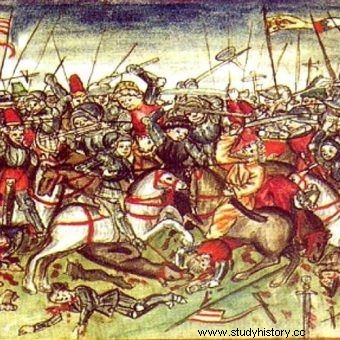
They included, inter alia, 12 white horses, 12 camels, 12 Cuman boys and 12 Ruthenian girls. In return, they only asked for two jugs of Danube water and a bunch of herbs. They quickly obtained permission to settle in Great Moravia. They got a finger and immediately decided to chop off the hand. Instead of peaceful coexistence, a bloody battle ensued, thanks to which the savage Magyars occupied the entire Pannonian Basin. And they were not going to stop there.
First impression effect
The Hungarians turned out to be an exceptionally energetic people. They spent most of the 10th century at war with all of Europe at that time. They went to Italy, to the territory of today's Germany, to southern France ... Describing one of the invasions on Saxony that took place during the reign of Henry I, a monk from New Korbea, Widukind, complained:
The Hungarians entered Saxony again, burned towns and villages with blood, shedding and wreaking great depopulation havoc. (...) It was such a (shame) harmful in those days that the monasteries suffered, but let us be silent about it, so as not to spread the word about these misfortunes.
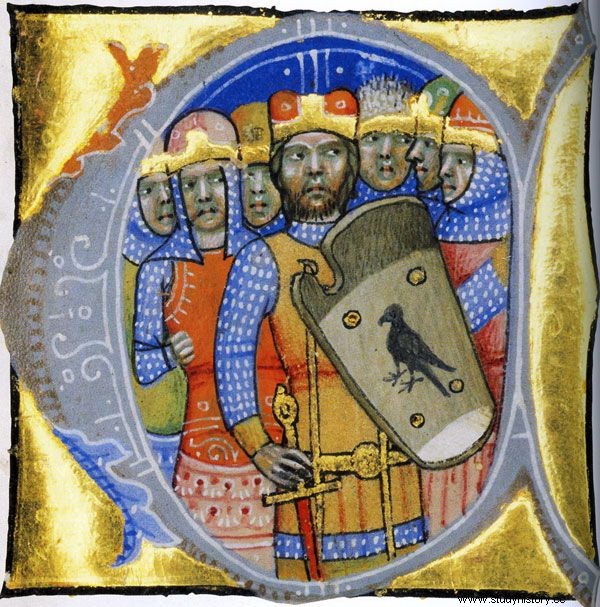
Battle Hungarians spent most of the 10th century at war with almost all of Europe. The miniature shows their leader and progenitor of the first Arpad dynasty with his team (source:Chronicon Pictum, public domain).
The so-called Korbe's Annalist. In AD 919, he noted: The Hungarians severely plundered Saxony and retreated to their lands with great spoils and captives of both sexes. God was angry with us .
They were also, at least initially, quite successful. They managed to get German and Italian princes and even the Byzantine emperor to pay tribute. Their position is evidenced by the fact that, as Widukind reported, Henry I, having taken prisoner of one of the Hungarian princes, preferred ... the promise of nine-year peace instead of ransom!
The expansion of the Hungarians was stopped only in the second half of the 10th century. The invasion of Germany ended with the Battle of Lechowy Pole in 955, where they were defeated by the troops of Otto I. The second major defeat took place in 970, when the Byzantines allied with Ruthenians, Bulgarians and Pechenegs managed to stop the Hungarian invasion. The very fact that the Byzantine emperor, in order to defend himself against the Hungarian invasion, called for help from all available allies is telling.
Bad press?
In this first century, incredible legends began to grow around the extraordinary military activity of Hungarians. Sometimes they appear as formidable cruelty, leaving behind only rubble and piles of bodies. Hungarian hordes were to set fire to every town on their way. They were said to be a "terrifying and cruel tribe", beasts "hungry for blood and devour people." Still in the 11th century Song about Roland they were referred to as "the spawn of Satan."
They killed all the men, taking only young women and children captive. These would be excesses well beyond the scope of "ordinary" war destructions ... It's just that it is not known if this image, well-established in literature, is true.
It is true that the chronicles and yearbooks, beginning with the first note, written in 862 by Hinkmar of Reims, are full of information about Hungarian expeditions. Hungarians are particularly accused of plundering the monastery in St. Gallen, where they were to kill the Alemannic aristocrat Viborada, later canonized by Pope Clement II. However, Idzi Panic - a professor at the University of Silesia and a specialist in the field of early history of the Magyars - insists that opinions about exceptional cruelty are ... unfairly unfair to Hungarians!
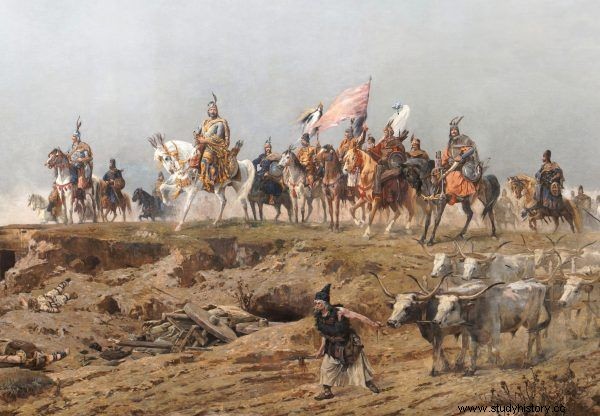
Was "Satan's spawn" not as terrible as it was painted? The painting shows Hungarian troops crossing the Carpathians led by Arpad (author:Árpád Feszty, public domain).
Their hostilities, although intense, did not exceed the accepted standards in his opinion. As he wrote, "they brought the Hungarians plentiful loot, their army plundered during the hostilities, but their behavior in the territory of the opponents did not differ in any way from the behavior of feudal troops".
According to Panic, the Hungarians even ... distinguished themselves positively against the background of the era, because they generally respected the territories of their allies. Moreover, the historian also allegedly questioned some information about their first battle in Europe. He suggested that the Magyars did come to East Pannonia at the invitation of the Great Moravian rulers, and that the settlement, at least initially, was peaceful.
New Huns
Perhaps this one detail was indeed confused in the centuries that followed. However, this does not change the fact that the Hungarians had a nasty press almost from the very beginning. Their way of fighting and their way of life were associated with the contemporary with Hun invasions at the turn of the 4th and 5th centuries. The new arrivals also settled in the same areas where the state of Attila had existed several centuries earlier. The relationship of the two peoples was quickly taken for granted.
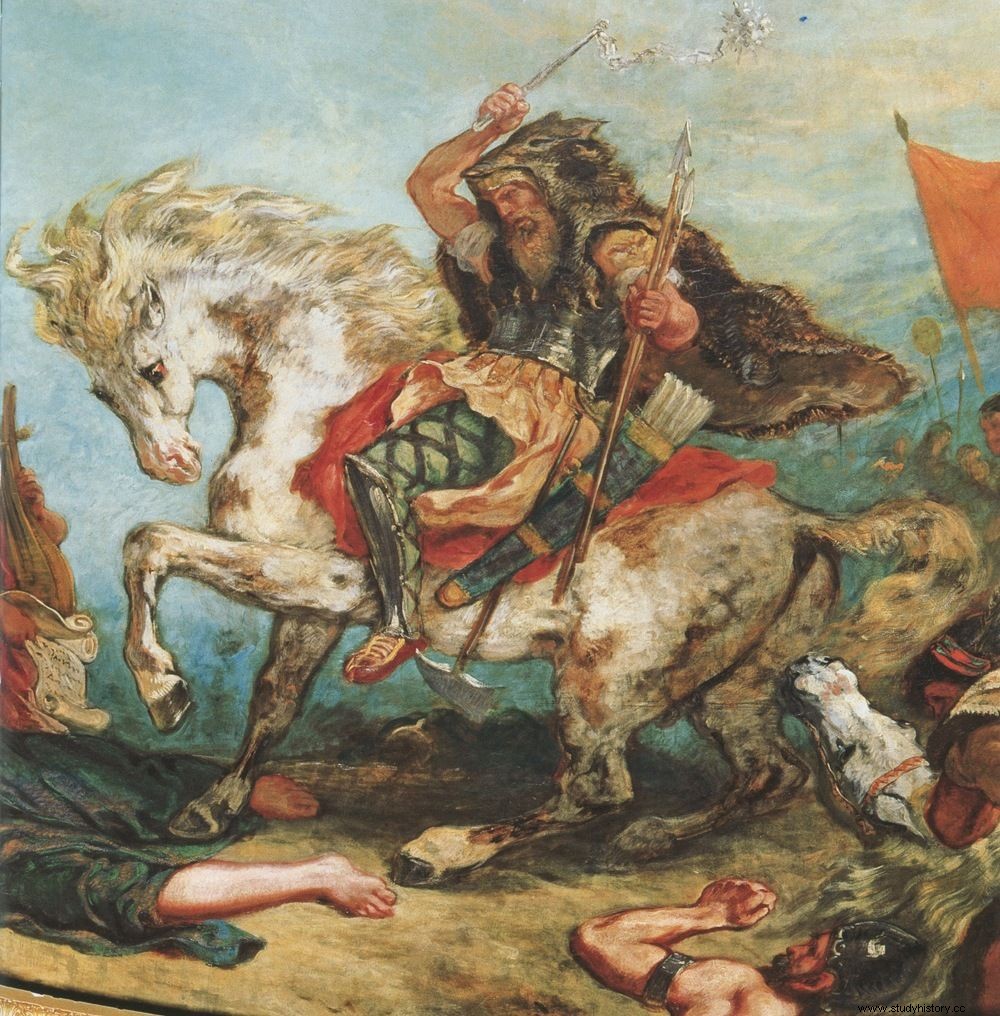
Medieval (and not only) people took it for granted that the Magyars were descendants of the Huns. Even the kings of Hungary considered themselves the successors of Attila. Detail of a painting by Eugène Delacroix showing the famous leader of the Huns (source:public domain).
It was by no means a flattering association, as can be seen, for example, in the description of the appearance of the first Hungarians, compared to the Huns and Avars. What, according to the Byzantine writers, comprised this physiognomy?
“They show their average height, disgusting features, hollow eyes and a voice similar to the roar of wild animals. Their customs also make them strangely harsh and barbaric, 'reported the historian J. Boldenyi. "This exaggerated image is a testimony to the blind hatred or gullibility of the chroniclers," he added immediately.
Widukind spoke equally contemptuously about the origin of the Hungarians, calling them "the remains of the Huns". Both were derived from the Goths, and more precisely - from Gothic women, accused of witchcraft and condemned by the Goth leader to exile. The "witches" were to hide in the forests where they gave birth to children and started a lineage "living according to animal habits, rude and relentless."
The thesis of Hunno-Hungarian kinship was so widespread in the Middle Ages that it was also given by our historian, Gall Anonymous. The territories of today's Hungary, in his opinion, were once Slavic, but later they were occupied by the "Huns, or Hungarians".
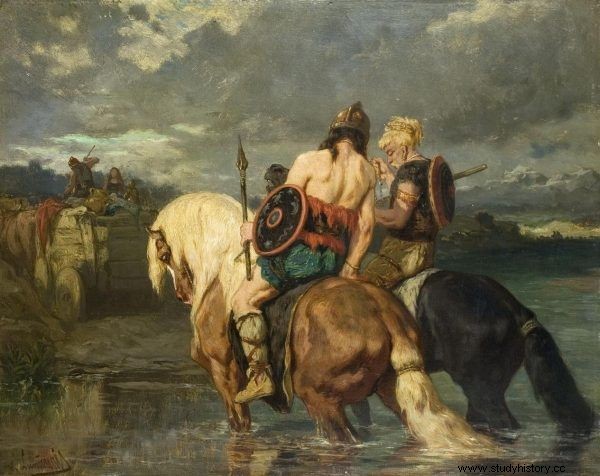
According to Widukind, the Magyars were the descendants of the exiled Gothic witches and their forest children. The painting shows the Goths crossing the river (by Évariste Vital Luminais, public domain).
This early medieval intuition turned into a widely discussed scientific hypothesis. Its confirmation was sought, among others, in linguistic research. Its first serious competition was the thesis about Finno-Ugric origin, which appeared around the 18th century.
Medieval spin
Interestingly, the Hungarians themselves, at least in the Middle Ages, did not completely reject Hun kinship. On the contrary, they tried to turn the shameful rumors to their advantage! The seemingly disgraceful lineage was used to justify Hungarian power in the occupied lands.
The first Hungarian chronicle from the 12th century Gesta Hungarorum , recognized Attila as the ancestor of Arpad, the founder of the native dynasty. The conclusion was obvious. Since the Hungarians were the heirs of the great leader, when occupying Eastern Pannonia, they did not so much invade foreign lands, but rather return to the old rubbish!
Over time, the image of the ancestor himself began to be intentionally whitewashed, emphasizing his bravery, wisdom and moderation. They became so attached to him that when the Finno-Ugric hypothesis appeared, it at first aroused strong protests. It was seen as an attempt to… diminish the importance of Hungary!
This is the PR masterpiece of the millennium. The Magyars believed that it is better to pass for the heirs of the great oriental culture (that is - nomen omen - the Huns!) Than of some pastoral people. And the fact that Attila was a murderer, a robber, and maybe even the first terrorist in history , he didn't bother them anymore…
